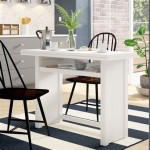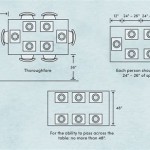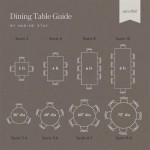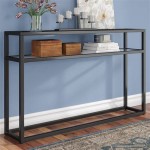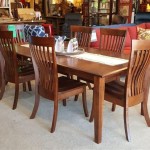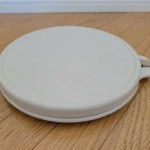Round Dining Table: A Space-Saving Solution for Modern Homes
The demand for efficient utilization of space within residential dwellings has steadily increased, particularly in densely populated urban areas. This escalating requirement has spurred innovation in furniture design, focusing on pieces that offer both functionality and spatial economy. Among these designs, the round dining table has emerged as a prominent solution for optimizing dining areas, regardless of the overall square footage of the home. Its unique shape and adaptability contribute significantly to creating a more versatile and visually appealing living environment.
Traditionally, rectangular dining tables have been favored for their perceived ability to accommodate a larger number of individuals. However, in smaller spaces, this shape can often create obstructions and limit freedom of movement. The round dining table, conversely, eliminates sharp corners and promotes a more fluid circulation pattern. This characteristic alone provides a tangible increase in the perceived and actual space available within the room. Furthermore, the circular form facilitates improved communication and interaction among diners, fostering a more connected and intimate dining experience.
The advantages of a round dining table extend beyond mere space conservation. The equitable seating arrangement inherent in its design naturally encourages inclusivity. No single diner is relegated to the perceived disadvantage of sitting at the "end" of the table, a common occurrence with rectangular configurations. This subtle shift in dynamics can positively influence the atmosphere of shared meals, promoting a more relaxed and democratic setting. The aesthetic appeal of a round table also contributes to its popularity. Its curves soften the angularity often found in contemporary interiors, adding a touch of elegance and visual interest to the dining space.
Maximizing Space with Strategic Placement
The effectiveness of a round dining table as a space-saving solution is significantly influenced by its placement within the room. Proper positioning is crucial to achieving optimal flow and maximizing the usable area. Ideally, the table should be centered within the designated dining space, allowing for equal clearance on all sides. This minimizes the potential for obstructions and ensures comfortable movement around the table. In smaller apartments or studios, positioning the table near a corner or against a wall can further conserve space; however, this may slightly compromise the inclusivity inherent in the round design.
The surrounding furniture also plays a vital role in maximizing the space-saving benefits of a round dining table. Opting for chairs with a streamlined design and minimal footprint can help prevent the area from feeling cluttered. Chairs that can be neatly tucked under the table when not in use are particularly advantageous in compact spaces. Consider incorporating mirrored surfaces on adjacent walls to create the illusion of greater depth and amplify the natural light, further enhancing the sense of spaciousness. Avoiding bulky storage units or overly large decorative items in the immediate vicinity of the table is essential to maintaining a clear and uncluttered aesthetic.
Beyond the furniture itself, consider the impact of rugs and lighting. A circular rug that complements the shape of the table can visually anchor the dining area and define its boundaries. However, ensure that the rug is appropriately sized, extending sufficiently beyond the table's perimeter to accommodate the chairs when occupied. A well-positioned pendant light or chandelier directly above the table can create a focal point and enhance the ambiance of the dining space. Dimmable lighting allows for adjusting the brightness to suit various occasions, from casual meals to more formal gatherings.
Choosing the Right Size and Material
Selecting the appropriate size of a round dining table is paramount to achieving both functional and aesthetic harmony within the dining area. The diameter of the table should be carefully considered in relation to the dimensions of the room and the number of individuals it is intended to accommodate regularly. A table that is too large will overwhelm the space and impede movement, while a table that is too small will feel inadequate and impractical.
A general guideline is to allow for at least 24 inches of space per person around the circumference of the table. This ensures comfortable elbow room and prevents diners from feeling cramped. For a table intended to seat four individuals, a diameter of approximately 36 to 48 inches is typically adequate. For six diners, a diameter of 48 to 60 inches is recommended. Larger round dining tables with diameters exceeding 60 inches can comfortably accommodate eight or more individuals, but these are more suitable for larger dining rooms.
The choice of material also significantly influences the overall aesthetic and functionality of the round dining table. Wood remains a popular choice due to its versatility, durability, and natural warmth. Different types of wood, such as oak, maple, and walnut, offer varying grain patterns and color tones to complement diverse interior design styles. Glass-topped tables provide a contemporary and airy feel, visually expanding the space and allowing light to pass through. Metal tables offer a sleek and modern aesthetic, often paired with wooden or glass accents for added visual interest. Consider the durability and maintenance requirements of each material when making a decision.
Versatility and Adaptability for Various Lifestyles
The round dining table's inherent versatility makes it a suitable choice for a wide range of lifestyles and living arrangements. Whether residing in a compact apartment, a sprawling suburban home, or a modern loft, the circular form adapts seamlessly to diverse spatial contexts. Its ability to foster intimate interactions and promote a sense of community makes it particularly well-suited for families, couples, and individuals who frequently entertain guests.
In smaller apartments and studios, the round dining table can serve as a multi-functional surface, accommodating both dining and work-related activities. Its compact footprint allows it to be tucked into a corner or positioned against a wall when not in use, freeing up valuable floor space. The egalitarian seating arrangement makes it ideal for collaborative projects or casual gatherings, fostering a sense of connection and shared experience. In larger homes, a round dining table can be used to create a more intimate dining area within an open-plan layout, defining the space and visually separating it from other living areas.
The adaptability of the round dining table also extends to its styling and decor. It can be dressed up or down to suit various occasions and personal preferences. A simple linen tablecloth and elegant tableware can transform it into a sophisticated setting for formal dinners, while a casual placemat and colorful accessories can create a relaxed and inviting atmosphere for everyday meals. The circular form also provides an ideal canvas for displaying centerpieces, such as floral arrangements, candles, or decorative objects, adding a touch of personality and visual interest to the dining space. The choice of chairs, lighting, and wall decor further enhances the overall aesthetic, allowing for a personalized and cohesive design.

Super Smart Space Saving Table Designs For Every Small Idee Arredamento Soggiorno Casa

Space Saving Dining Tables For Minimalist Room Home Interiors Table Small

Space Saving Round Shape 4 Seater Dining Table Se

Round Oak And Brown Linen Space Saving Dining Table Chairs Seconique Furniture123

15 Space Saving Dining Table Ideas For Home

Where To Buy Best Space Saving Dining Tables

Modern Round Dining Table And Chair Set Combination

Buy The Oslo 120cm Black High Gloss Stowaway Dining Table And Chairs At Oak Furnitu Space Saver Saving Round

Where To Buy Best Space Saving Dining Tables

15 Space Saving Dining Table Ideas For Home



